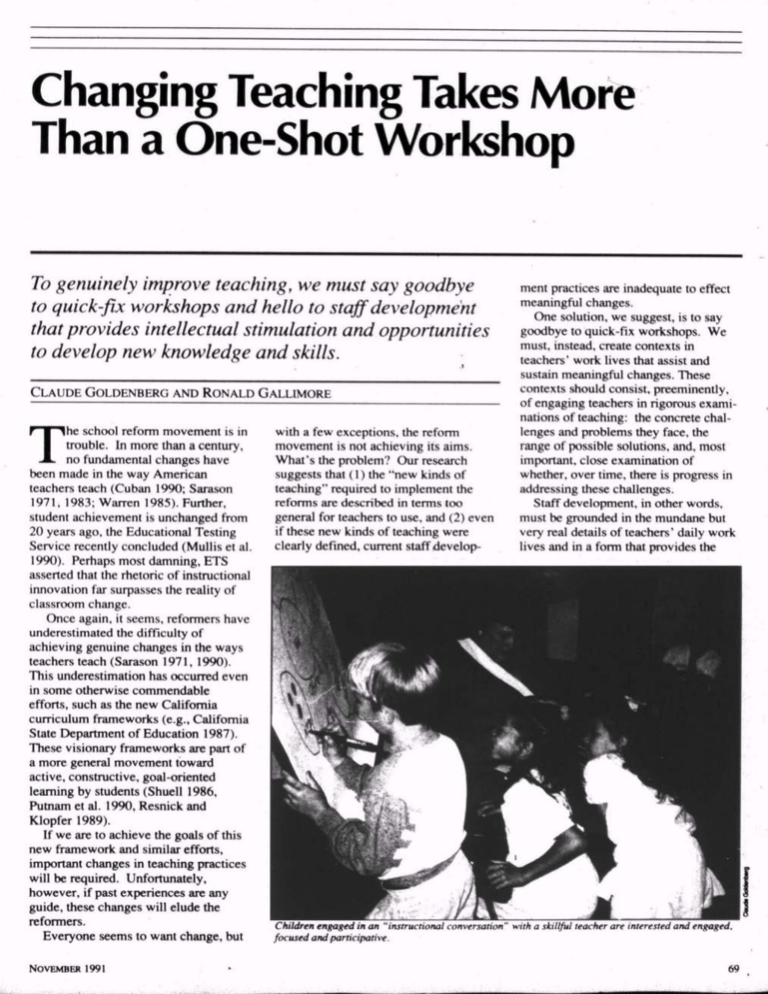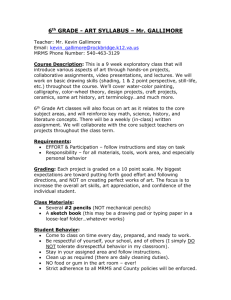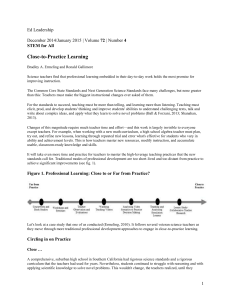
Changing Teaching Takes More
Than a One-Shot Workshop
To genuinely improve teaching, we must say goodbye
to quick-fix workshops and hello to staff development
that provides intellectual stimulation and opportunities
to develop new knowledge and skills.
CLAUDE GOLDENBERG AND RONALD GALLIMORE
T
he school reform movement is in
trouble. In more than a century,
no fundamental changes have
been made in the way American
teachers teach (Cuban 1990; Sarason
1971, 1983; Warren 1985). Further,
student achievement is unchanged from
20 years ago, the Educational Testing
Service recently concluded (Mullis et al.
1990). Perhaps most damning, ETS
asserted that the rhetoric of instructional
innovation far surpasses the reality of
classroom change.
Once again, it seems, reformers have
underestimated the difficulty of
achieving genuine changes in the ways
teachers teach (Sarason 1971, 1990).
This underestimation has occurred even
in some otherwise commendable
efforts, such as the new California
curriculum frameworks (e.g., California
State Department of Education 1987).
These visionary frameworks are part of
a more general movement toward
active, constructive, goal-oriented
learning by students (Shuell 1986,
Putnam et al. 1990, Resnick and
Klopfer 1989).
If we are to achieve the goals of this
new framework and similar efforts,
important changes in teaching practices
will be required. Unfortunately,
however, if past experiences are any
guide, these changes will elude the
reformers.
Everyone seems to want change, but
NOVEMBER 1991
with a few exceptions, the reform
movement is not achieving its aims.
What's the problem? Our research
suggests that (1) the "new kinds of
teaching" required to implement the
reforms are described in terms too
general for teachers to use, and (2) even
if these new kinds of teaching were
clearly defined, current staff develop
ment practices are inadequate to effect
meaningful changes.
One solution, we suggest, is to say
goodbye to quick-fix workshops. We
must, instead, create contexts in
teachers' work lives that assist and
sustain meaningful changes. These
contexts should consist, preeminently,
of engaging teachers in rigorous exami
nations of teaching: the concrete chal
lenges and problems they face, the
range of possible solutions, and, most
important, close examination of
whether, over time, there is progress in
addressing these challenges.
Staff development, in other words,
must be grounded in the mundane but
very real details of teachers' daily work
lives and in a form that provides the
Children engaged in an "instructional conversation" with a sldllful teacher are interested and engaged,
focused and participative.
69
A stillful teacher knows when to bear down to
draw oui a student's ideas, and when to ease up.
keeping everyone on track
intellectual stimulation of a graduate
seminar. By intellectual stimulation, we
mean engagement with the substantive
knowledge to be taught and the
sustained analysis of teaching as a
professional pursuit.
In our research, and to help advance
the goals of efforts such as the new
California curriculum frameworks,
we've attempted to work with teachers
in precisely this way. Some of what
we've learned is summarized here.
Wanted: Definitions of
New Practices
We have been working with small
groups of early elementary teachers to
encourage them to use what we call
"instructional conversations"
(Goldenberg and Gallimore 1991; Tharp
and Gallimore 1988, 1989). In a sense,
there is nothing new about instructional
conversations (ICs). In one form or
another, teachers have been talking
about this type of interaction with pupils
for millennia, although it seems to get
talked about more than done. Most
people have a reasonably intuitive sense
of what such a discussion is like. At its
very best:
• It is interesting and engaging.
• It is about something. It has a focus
which evolves, but remains discernible
throughout.
• There is a high level of participa
70
tion, without undue domination by
anyone, particularly the teacher.
• Students engage in extended discus
sions with the teacher and among them
selves, exploring ideas and thoughts indepth.
• A teacher (or discussion leader)
questions, challenges, clarifies,
coaxes—or keeps quiet. The teacher
knows when to bear down to draw out a
student's ideas, and when to ease up,
keeping everyone on track without
squelching participation, reflection, and
diversity of thought.
• The tone of the discussion varies,
from an electrically charged give-andtake to a more quietly thoughtful tone.
Either way, participants' minds are
engaged in extended verbal exchanges
with one another, which allow them to
reach new levels of understanding.
Wanted: Precepts for Learning
New Practices
Virtually every California teacher and
administrator with whom we've worked
immediately recognizes that instruc
tional conversation, or something like it,
is essential to making the new frame
works succeed, particularly in the
language arts. Some claim they already
do it. But many also recognize that
conducting such conversations involves
skills few teachers have learned well
enough to execute systematically and
intentionally.
Our experiences in California and
Hawaii suggest that when the kind of
professional development contexts
needed to learn to use ICs skillfully and
purposefully are provided, teachers can
learn them and use them to help imple
ment the California framework and
comparable innovations (Goldenberg
and Gallimore 1991; Rueda et al. 1991;
Tharp and Gallimore 1988, 1989).
Our research on professional devel
opment contexts points out what is
required for teachers to leam teaching
skills as complex as 1C:
1. Teachers must have opportunities
to meet with colleagues and a skilled
consultant for an extended period for
the explicit purpose of learning new
knowledge and skills. For example, in
our most current work, Goldenberg met
weekly after school for two hours,
during a school year, with groups of
four to six teachers. Teachers in Hawaii
also met regularly with consultants to
analyze previous lessons and plan
futures ones. The meetings had many
of the same conversational and instruc
tional features as ICs. Over time,
teachers increased their ability to imple
ment new modes of teaching (Rueda et
al. 199l,Saundersetal. 1991, Tharp
and Gallimore 1989).
2. Meetings should be productively
organized around teachers' perceived
needs in their own classrooms.
Teachers with whom we worked felt
that something was missing from their
classroom instruction. Recitation or
direction instruction—the stock-in-trade
of U.S. schools—is useful for certain
purposes but has limited utility in other
domains, such as those implicitly
suggested by the California Language
Arts Framework.
3. A specific goal should emerge
within a reasonable amount of time and
remain the focal point of a group's
work. For example, in 1989-90,
although the teachers began with
different conceptions of alternative
teaching modes they wished to explore,
by the third month all agreed that
instructional conversations represented
the common elements they wanted to
achieve. "Doing instructional conversa
tions," they came to realize, was one
EDUCATIONAL LEADERSHIP
way of putting the spirit of the Californian framework into action. This
concept, then, provided a tangible focus
for the group's activities, affording them
a relatively clear agenda, even if the
group's understanding of instructional
conversation was sometimes murky.
4. The context for teachers' skill
development must be intellectually stim
ulating, and teachers must acquire a
conceptual understanding ofpedagog
ical processes as well as learn new
techniques. At the beginning of the
1989-90 year, for example, the group
talked in general terms about the need to
enhance children's language use,
promote higher-level thinking, and so
forth, but without conceptualizing the
sorts of teaching/ learning interactions
required to achieve these goals.
Through readings, discussions, and
videotaped lessons, the group came to
conceptualize and use ICs, identifying
specific elements designed to promote
desired educational aims.
Our sessions also helped clarify the
point that for some goals and objec
tives—many of which are very impor
tant—direct instruction is applicable;
moreover, it can be used in conjunction
with 1C as pan of an overall instruc
tional program. The teachers' analytical
mastery of pedagogy was enhanced as a
result of our meetings, a crucial factor
in their development of 1C skills and
surely a prerequisite for using the
conversations.
5. Teachers who wish to do instruc
tional conversations must thoroughly
study the intellectual substance of what
is being taught through the conversa
tions. After considerable inconsistency
throughout the year, for example, one
teacher showed dramatic improvement
in her 1C lessons. When asked why, she
responded, very simply, that having
"studied the story" she was reading with
the group of children had made a big
difference.
Some of the group sessions resembled
a graduate seminar in literature. Plan
ning came to be seen more as "mental
preparation" than as writing out objec
NOVEMBER 1991
tives, procedures, and so forth. Teachers
had to understand the story (even if it
was in a 1st grade basal reader) and think
about how to help students derive the
greatest possible meaning from it—how
to talk about it, in other words, in a way
that would "enlarge [their] understanding
of ideas and values" (Adler 1982). The
intellectual—as opposed to procedural—
side of lesson planning is rarely
mentioned in discussions of training
teachers to teach in new ways. Yet we
found it to be critical.
6. Videotaping teachers' lessons and
providing opportunities for them to
review and analyze their efforts to do 1C
are indispensable. The tapes help focus
and sharpen the group's efforts and
provide teachers with unambiguous
feedback on their lessons. Simply
watching themselves and having an
opportunity to, as one teacher said,
"self-analyze" causes teachers to reflect
on the quality of their lessons and direct
later efforts in particular directions. Our
analysis of meetings over a year's time
showed a dramatic decrease in the
number of generalized comments
teachers made and an increase in the
number of analytical statements.
Viewing the lessons was not always a
pleasant experience, especially at first.
Many of the initial meetings opened
with teachers' disclaimers for the tape
to be viewed that day: The story was
inappropriate for an 1C lesson; the
students were unusually distracted; chil
dren had insufficient language or expe
rience; and so form. But the selfconsciousness that accompanied
watching the tapes was very important.
It prompted the teachers to attend to the
10 Principles of
Instructional Conversations
Instructional conversations suggest a
way to achieve the ambitious, but
elusive, educational goal of helping
students comprehend texts and
complex ideas. This land of teaching
might be particularly important for
students who lack adequate opportu
nities for academic, conceptual, and
linguistic development at home. ICs
comprise 10 principles:
1. Based on a thorough under
standing of the text being used, the
teacher selects a theme or ideas to
serve as a starting point for focusing
the discussion.
2. The teacher either "hooks into"
or provides students with pertinent
background knowledge.
3. The teacher provides direct
Ttwhing r
f p dril1 9f ftfT* «*»«"
necessary.
4. The teacher stretches students'
zone of performance by promocmg
and eliciting more extended language
and expression.
5. The teacher promotes students'
use of text, pictures, and reasoning
to support an argument or position.
Conversational Principles
6. Much of the discussion centers
on questions and answers for which
there might be more man one correct
answer.
7. The teacher responds to unan
ticipated comments and opportuni
ties for discussion provided by
students.
8. The discussion is characterized
by multiple, interactive, connected
turns, where succeeding utterances
by teachers and students build upon
and extend previous ones.
9. The atmosphere is challenging
but nontntcairntng.
10. All students fed free and
encouraged to participate.
—Claude OoMenberg
71
details of their own behavior (Carver
and Scheier 1981), then adjust their
behavior to meet the standards they
were jointly developing—in this case,
using 1C lessons. Being observed or
taped is a key to initiating the self-anal
ysis process on which professional
development depends (Gallimore et al.
1986; Tharp and Gallimore 1988, Chap
ters 9, 10, and 11).
7. Teachers need one to two years of
intensive work to achieve a reasonable
mastery of 1C skills. Some do it more
quickly, but they are exceptional. This
insight from our research helps explain
why so many past efforts to change
teaching practices have not succeeded.
Many of the needed changes in teaching
are hard to achieve, and there is no
tradition in U.S. education for training
of the length and intensity required to
achieve substantive change.
Needed: Fundamental Change
in Schools
What if our conclusions are right?
What if such extraordinary efforts are
needed to achieve the goals of the Cali
fornia Framework and other such
reforms?
We do not think the answer lies in the
creation of a huge, but temporary,
training program but, rather, in perma
nent andfundamental change in
schools.- Such a change would ensure
that the intellectual and professional life
of a teacher becomes more stimulating,
demanding, and satisfying.
An indispensable feature of this
change must be opportunities for
teachers to do detailed and continuing
analysis of their teaching in a context
with the atmosphere and substance of a
graduate seminar. What teachers did in
our research projects should become a
permanent feature of teaching life, not a
one-shot training program. Without such
changes in the structure of schools and
the daily life of teachers, it is unlikely
that the California Framework or any
other reform will have lasting impact.
But much of this has been said
before. Sarason pointed it out over 20
years ago. Perhaps Gide, as Cuban
(1990) has recently reminded us, was
right: "Everything has been said before,
but since nobody listens, we have to
keep going back and begin again." LJ
References
Adler, M. (1982). The Paideia Proposal:
An Educational Manifesto. New York:
Macmillan.
California State Department of Education
(1987). English-Language Arts Frame
work for California Public Schools.
Sacramento, Calif.: California State
Department of Education.
Carver, C. S., and M. F. Scheier. (1981).
Attention and Self-Regulation: A
Control-Theory Approach to Human
Behavior. New York: Springer-Verlag.
Cuban, L. (1990). "Reforming Again,
Again, and A,gain."Educational
Researcher 1 9, 1: 3-13.
Gallimore, R., S. Dalton, and R. G. Tharp.
(1986)."Self-Regulation and Interactive
Teaching: The Impact of Teaching
Conditions on Teachers' Cognitive
Activity." Elementary School Journal
86,5: 613-631.
Goldenberg, C., and R. Gallimore. (April
1991). 'Teaching and Learning in a
New Key: The Instructional Conversa
tion." Paper presented at the annual
meeting of the American Educational
Research Association, Chicago, 111.
Mullis, I., E. Owen, and G. Phillips.
(1990). America's Challenge: Acceler
ating Academic Achievement. Princeton,
N.J.: Educational Testing Service.
Putnam, R., M. Lamport, and P. Peterson.
(1990). "Alternative Perspectives on
Knowing Mathematics in Elementary
Schools." Review of Research in Educa
tion 1 6: 57-150.
Resnick, R., and L. Klopfer, eds. (1989).
Toward the Thinking Curriculum:
Current Cognitive Research. Alexandria,
Va.: Association for Supervision and
Curriculum Development.
Rueda, R., C. Goldenberg, and R.
Gallimore. (April 1991)."When Is An
Instructional Conversation?" Paper
presented at the annual meeting of the
American Educational Research Associ
ation, Chicago, 111.
Sarason, S. B. (1971). The Culture of the
School and the Problem of Change.
Boston: Allyn and Bacon.
Sarason, S. B. (1983). Schooling in
America: Scapegoat and Salvation.
New York: The Free Press.
Sarason, S. B. (1990). The Predictable
Failure of Educational Reform: Can We
Change Course Before It's Too Late?
San Francisco: Jossey-Bass.
Saunders, W., C. Goldenberg, and J.
Hamann. (April 1991)."Instructional
Conversations Beget Instructional
Conversations." Paper presented at the
annual meeting of the American Educa
tional Research Association, Chicago,
III.
Shuell, T. (1986). "Cognitive Conceptions
of Learning. "Review of Educational
Research 56: 411-436.
Tharp, R., and R. Gallimore. (1988).
Rousing Minds to Life: Teaching.
Learning, and Schooling in Social
Context. Cambridge, England:
Cambridge University Press.
Tharp, R., and R. Gallimore. (1989).
"Rousing Schools to Life." American
Educator 1 3,2: 20-25+.
Warren, D. (1985). "Learning from Expe
rience: History and Teacher Education."
Educational Researcher 1 4, 10: 5-12.
Authors' note: The research reported here
was made possible by a grant from the Presiden
tial Grants for School Improvement Program.
Office of the President. University of California,
and by the Linguistic Minority Research Project
of the University of California. Additional
support has been provided by the National Center
for Research on Cultural Diversity and Second
Language Learning, administered by the Office
of Educational Research and Improvement
(OERI). U.S. Department of Education. Our
thanks to Bill Saunders. Robert Rueda, and the
children, administrators, and—most especially—
the teachers of the Lennox, California. School
District who have participated in the research
described here.
Claude Goldenberg is Assistant Research
Psychologist, and Ronald Gallimore is
Professor, University of California—Los
Angeles, Department of Psychiatry and
Biobehavioral Sciences, School of
Medicine, 760 Westwood Plaza, Los
Angeles, CA 90024.
EDUCATIONAL LEADERSHIP
Copyright © 1991 by the Association for Supervision and Curriculum
Development. All rights reserved.







